Callback Management in a Campaign
Here, Group Manager can add a callback, view the callbacks with filters, and manage them.

Figure: Callback Management in a Campaign
Group Manager can perform the following operations.
Add a Callback
Group Manager can add any callback by following the below steps.
-
Click "Add Callback" button. It shows the following pop-up.
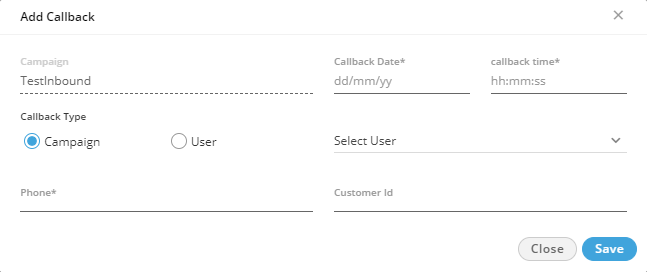
Figure: Adding a Callback
-
Select the callback date & time (mandatory fields) from the calendar option.
-
Select any of the following callback types.
-
Campaign: Select it if the callback has to be scheduled for the respective campaign in which Group Manager is logged in.
-
User: Select it if the callback has to be scheduled for a selected user. After selecting user, select the user, for whom callback has to be scheduled, in the drop-down menu.
-
-
Enter the phone number (mandatory field) on which callback has to be scheduled.
-
Enter the Customer ID, if applicable. Else, leave it blank.
-
Click "Save" button to save the callback details.
Multiple Callbacks can be scheduled here.

Figure: Added Callbacks
Edit Callbacks
Select the Call from the list of the available callbacks which you want to reschedule. After selecting the call, the "Edit" button starts displaying at the left top of the page. Click "Edit" button. A pop-up containing complete detail of the call comes up.
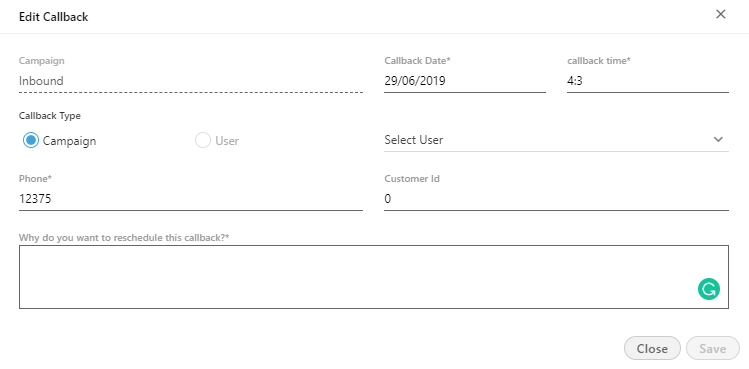
Figure: Edit Callbacks
On the pop-up, you can change the Callback date, callback time, phone number, and the agent name as well. After changing all the information, you have to enter the reason for which you are rescheduling the callback. The reason is mandatory which means you have to fill it.
Click "Save" button to save the changes made.
Limitations for Editing callbacks
Following are some limitations of editing callbacks for the Group Manager.
Group Manager cannot change the campaign callbacks to user-specific callbacks, but user-specific callbacks can be changed to campaign callbacks.
Group Manager cannot edit multiple callbacks at once. However, multiple callbacks can be deleted at once.
Search Callbacks
The Group Manager can search for the callbacks with the help of customer's Id, Customer's phone number and customer's name. It helps the Group Manager to search the callback with comparatively higher speed and
Extract Callbacks
You can select multiple callbacks and click "Extract" in this pop-up to save the details of Callbacks as a CSV file on the disk. It shows the following dialog box.
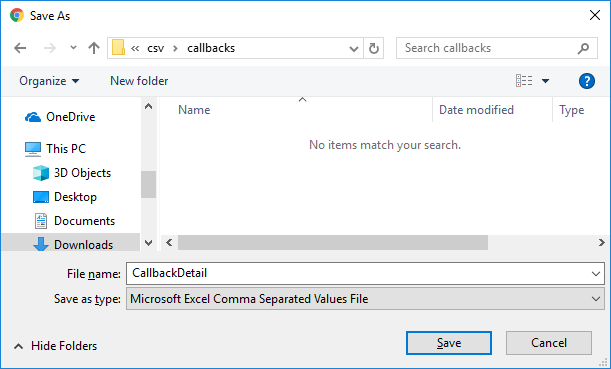
Figure: Extract Callbacks
Select the location and provide a name to the file. Click "Save" to save the details of callbacks in a file.
Settings
The Group Manager can set callback configuration by clicking ![]() icon to access the callback settings. It shows the following pop-up.
icon to access the callback settings. It shows the following pop-up.
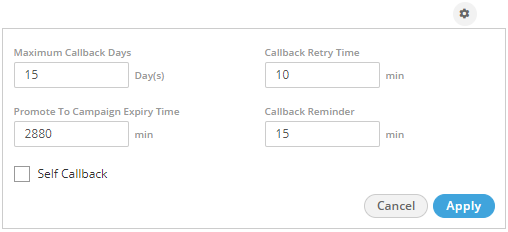
Figure: Configure Callback
-
Self Callback: If this option is enabled (checkbox is checked) then the callbacks set using force dispose would be self callback by default.
-
Max Callback Days: Group Manager can define the maximum number of days after which the callback would be deleted from the system.
-
Promote To Campaign Expiry Time (min): It refers to the maximum number of minutes after which the self callback (if not attended by the respective agent) will get expired and transferred to the campaign (that is it can then be routed to any available agent of the campaign).
-
Callback Retry Time (min): It is the time after which callback will be dialed again in case it is failed in the previous attempt.
-
Callback Reminder (min): It is the time before which the callback notification will be displayed in the notification bar of the respective agent or Group Manager for the scheduled callbacks.
Filter the View
Group Manager can click ![]() icon to filter the callbacks.
icon to filter the callbacks.
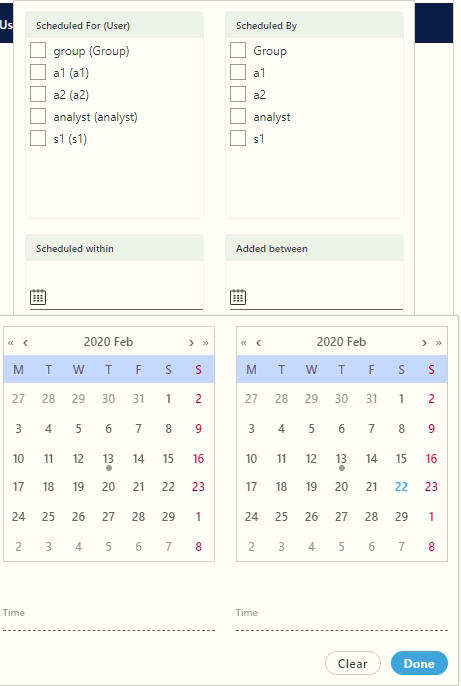
Figure: Filter Callbacks
It contains the following filters.
-
Groups (Group Manager): Select the name of the groups and group managers to whom the scheduled callback agent is assigned in.
-
Scheduled for (User): Select the users of which callbacks have to be displayed.
-
Scheduled within: Select the time range in "From" and "To" for those callbacks which are scheduled in the given time range.
-
Scheduled By (User): Select the users who created the callbacks.
-
Added Between: Select the time range in "From" and "To" for those callbacks which are scheduled in the given time range.
-
Phone Number: The group manager can also provide the phone number of to filter the callbacks scheduled for that phone number.
There is no need to provide date and time from different places. All can be done through one place. Click at "Scheduled By (User)" or "Added Between" to provide date and time simultaneously.
Click "Apply" to apply the filters. After applying the filters, the Group Manager can click "Clear" to clear the filter and restore the default view of the callbacks.
Delete Callback
Click "Delete" button to delete the selected callback. A pop-up arises in which you have to provide the reason for which you are deleting the callback. Without providing the reason, the callback will not delete.
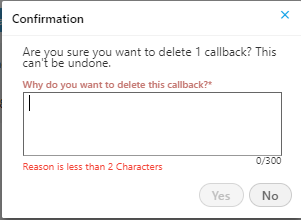
Figure: Delete Callbacks
Notification for the Scheduled Callback
A notification will be shown to the group manager when a callback has been scheduled in the campaign. It contains the phone number for which the callback is scheduled, the campaign name and the time for which the callback is scheduled.
If the number masking is enabled for that campaign, then it will mask the phone number in the displayed notification as well.
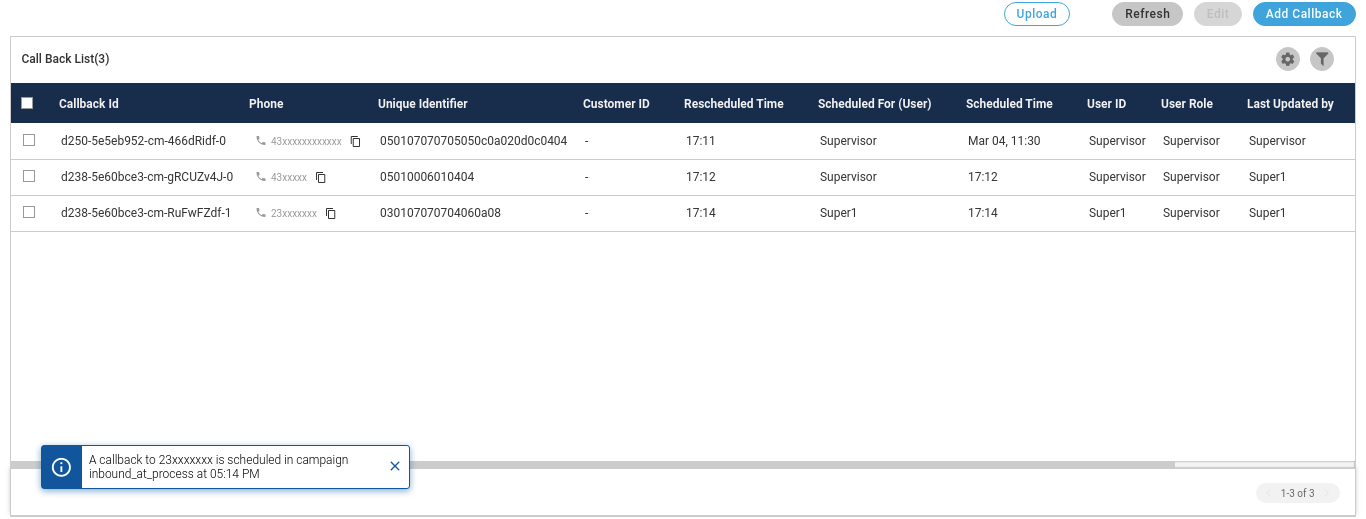
Figure: Callback Management in a Campaign
(Licensable) Bulk Migration of Callbacks between Campaigns
It is possible that those agents to which the callbacks are assigned has been moved to another campaign due to any reason. In such cases, the callbacks assigned to such agents can also be assigned back to them.
Perform the following steps.
In the "Callback" tab, the following screen is displayed on which you have to upload the CSV.
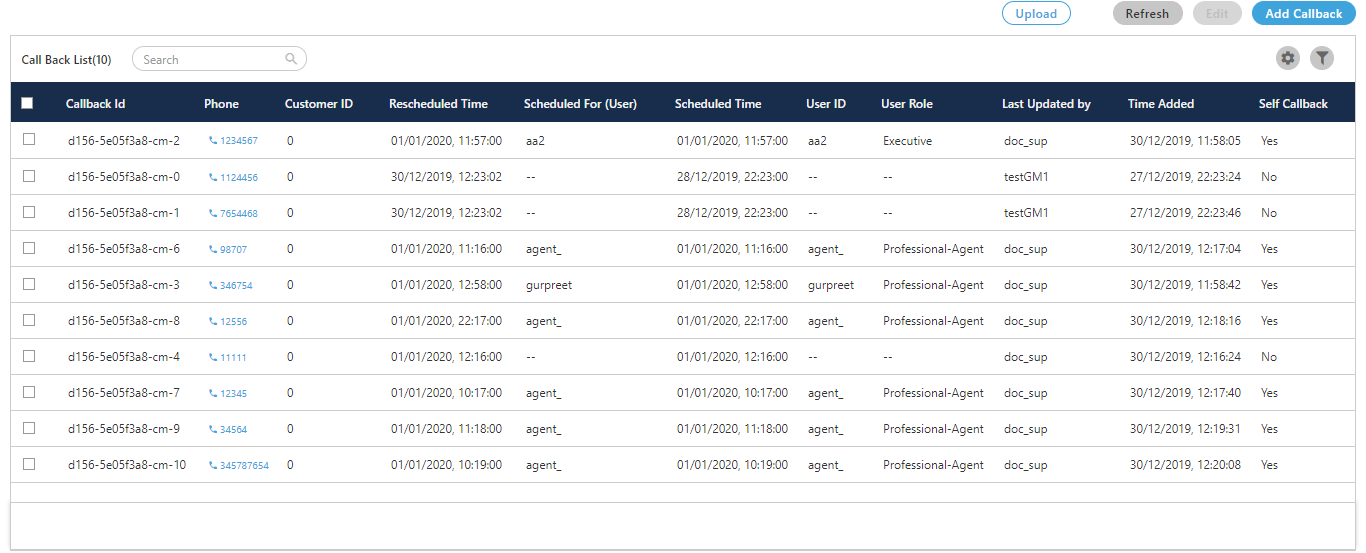
Figure: "Manage Callback" Page
Select the callbacks that have to be downloaded.
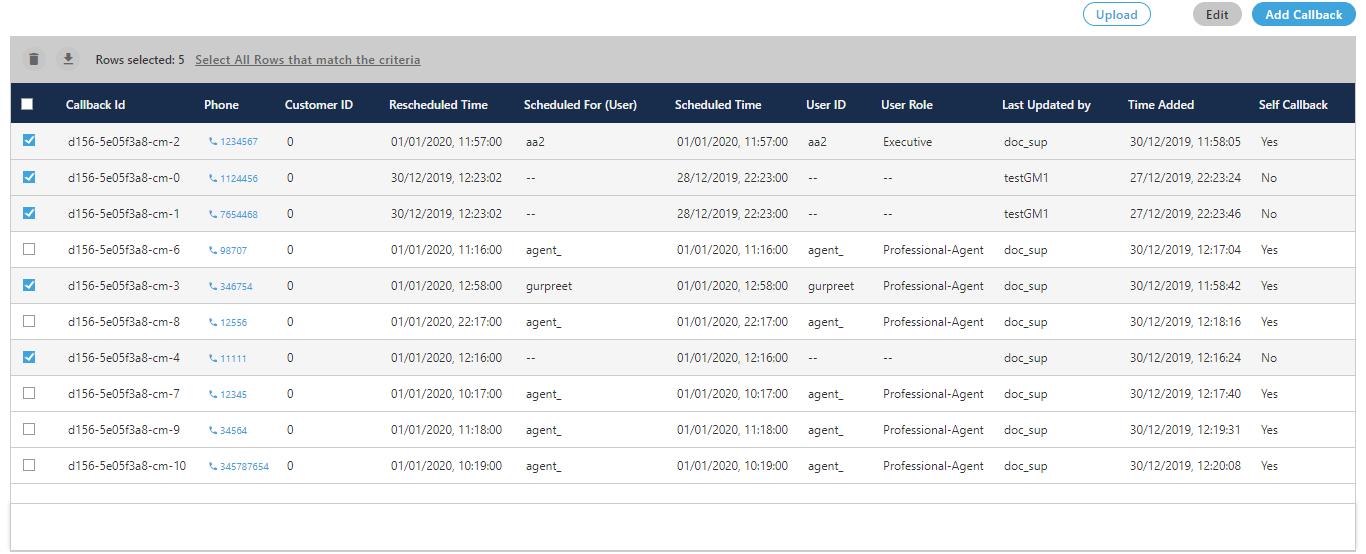
Figure: Selected the Callbacks
The Group Manager can select a maximum of up to 10,000 callbacks at a time.
On a single page of callbacks, only 10 records are displayed. If you want to select all the records which are not visible on the page, then you can click "Select All Rows" link. It will select all the rows of callbacks.
Click
 icon to export or extract these callbacks. It shows the following modal.
icon to export or extract these callbacks. It shows the following modal.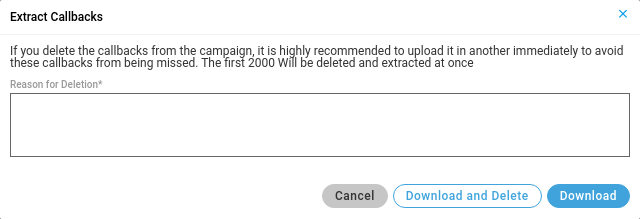
Figure: Modal to Export and Extract the Callbacks
Provide a reason to export or extract the callbacks.
Click "Export" to export the callbacks and download them to a CSV file.
Click "Extract" to export the callbacks to a CSV file and delete them from Ameyo System.
This option is based upon "Save As" functionality of the Web browser. If "Ask where to save each file before downloading" or similar option is not checked, the CSV file will be saved at the default download location of the Web browser, of which name is "CallDetails". In this case, the Group Manager or the Group Manager does not get the option to change the name and path of the file.
It is recommended to keep the option "Ask where to save each file before downloading" checked so that you can specify the name and path to save the files.
If "Ask where to save each file before downloading" option is checked, then the following dialog box is displayed while saving the CSV file.

Figure: Save CSV File
The following screenshot shows a sample CSV.

Figure: Sample CSV File containing the callbacks
Upload the Callbacks
Perform the following steps to upload the callbacks.
Click "Upload" to upload the callbacks. It shows the following modal.
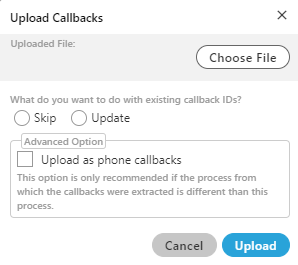
Figure: "Upload CSV" Modal
Click "Upload" to upload the CSV files to add the callbacks. It shows the following modal.
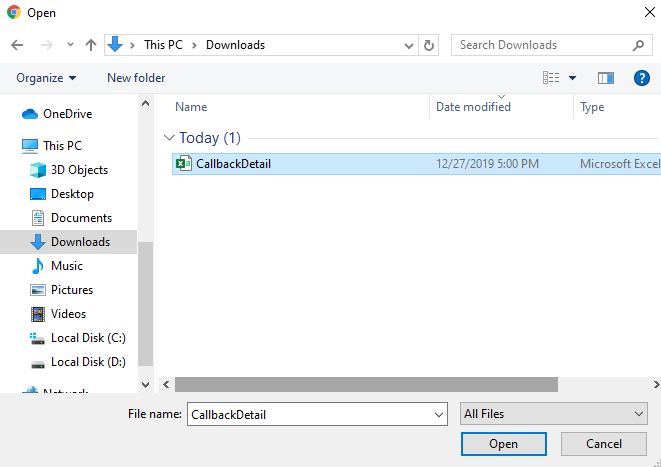
Figure: Dialog Box to open the file
Select the location where you have saved the file.
Select the CSV file and click "Open" to open the file.
CSV file is selected in "Upload CSV" Modal.
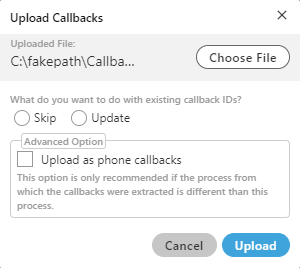
Figure: Dialog Box to open the file
Select any of the following options.
Skip: Select it to skip any operation to be done on the callback-id, that is, all the Callback IDs will be the same as used before.
Update: Select it to update the callback-id for those callbacks which have been updated in the CSV file.
Upload as phone callback: Enable this feature if all the callbacks which you have uploaded are phone calls. It is recommended to use this option only when the process is different while uploading.
Click "Upload" to upload the callbacks else, click "Cancel" button. The uploading process takes some time, depending upon the size of the callbacks. The following notification pop-up is displayed now, which contains the list of errors or number of records that are uploaded successfully.
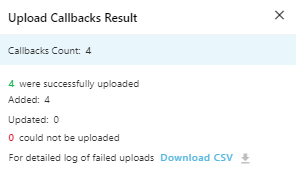
Figure: Uploaded the Callbacks
If there is any error while uploading the callback CSV, then the Group Manager can download the CSV for failure reasons, if any.
Once the callbacks have been updated, a notification is sent to all the group managers and agents of that campaign.
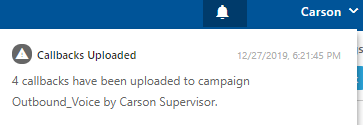
Figure: Notification of Uploading the Callback
If the uploading time of callback is greater than the scheduled time of callback, then the callback will schedule to the present time.
For Example:
Suppose, the callback scheduled time is 11:00, but the callback is extracted and deleted at 10:00, and it is uploaded at 12:00, then the callback time will schedule automatically to the present time, that is, 12:00.
Changing the User Assignment of Callbacks in Bulk
There is a possibility that the agent is not present, transferred to another campaign or left the job. In such cases, the callbacks assigned to that agent will remain unfollowed. In such cases, the Group Manager can assign these callbacks to another agent, so that the callbacks will not be left unfollowed.
Select those callbacks which have to be modified.
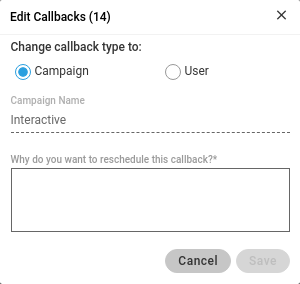
Figure: Bulk Edit of Callbacks
The Group Manager or Group Manager has to select the callbacks in "Callbacks" Tab and click "Edit" button to edit these callbacks in bulk. Here, you can either promote the callbacks to "Campaign" or change the user assigned to these callbacks. If the callbacks are already assigned to the multiple users, then a message is displayed in "Edit Callback" modal.

Figure: Bulk Edit of Callbacks already assigned to the multiple users
If bulk callbacks have been assigned to a user and that the user has been unassigned from the campaign, then the Group Manager still can see and manage the scheduled callbacks assigned to that user.
Toast Notifications
If the Group Manager or Group Manager changes the user assignment of the callbacks, then a toast notification is displayed to them.

Figure: Toast Notification on the successful bulk operation
If the Group Manager or Group Manager tries to change the user assignment of the callbacks more than the configured limit, then the toast notification displays the error message.

Figure: Toast Notification shows the error when the callbacks more than the limit are being tried
Notification to the User Consoles
If a user is assigned the callbacks in bulk, then a notification is displayed to the console of that user.

Figure: Notification to the Agent upon assignment of the bulk callbacks
Notification will be displayed to all Group Managers in case of bulk update of callbacks. If a user has been assigned multiple callbacks then a notification will be displayed to the user.